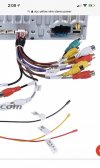I
Not quite. Here in the US now for residential house wiring ground
if jacketed is green or
can be bare, and no other usage is allowed for green wires. If an appliance requires a separate cabinet ground, it must be green while the working ground is bare. You are now also required to use
only green colored wire nuts (connectors) on ground circuits, although no color is specified for other approved ground wire connectors or for other uses. With Romex (non-metallic sheathed) /3 cables (used to be called /3wg), the 4th conductor is
usually red but can actually be any color other than black, white, green, or bare. You used to occasionally see an orange wire there but it seems the cable manufacturers now use only red for this application (not sure if that was a requirement on their end or what). When upgrading non-grounded polarized systems now, the added ground wire must also be green only, though bare was once permitted in this use.
Thankfully everyone here uses the latest NEC (National Electric Code), but for the other parts of Building codes, I normally work in 6 different Code Enforcement districts to 4 different Building Codes, and it can sometimes drive you crazy

Phil



